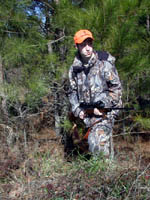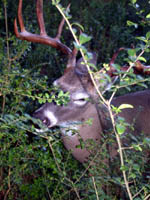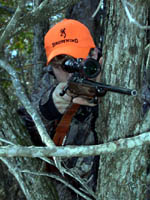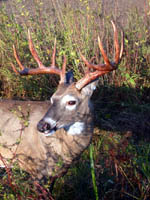
|
Features
|
|
|
|
Books
|
|
|
|
Fun & Games
|
|
|
|
Contact Us
|
|
|
John's Journal... Entry 177, Day 1
HUNT RUTTING BUCKS NOW
Hunt Rutting Bucks Now
 EDITOR'S
NOTE: Hunters have chased them, shot at them, cussed
them, spooked and aggravated them all season long. But the biggest, the
oldest and the smartest bucks on any property you hunt have managed to
survive until the end of the season. These large, older bucks write the
textbooks young bucks study to survive. Some of the nation's best hunters
employ strategies that will take these end-of-the-season rutting bucks
each year. These masters of the hunt tell us their tactics for bagging
late-season bucks.
EDITOR'S
NOTE: Hunters have chased them, shot at them, cussed
them, spooked and aggravated them all season long. But the biggest, the
oldest and the smartest bucks on any property you hunt have managed to
survive until the end of the season. These large, older bucks write the
textbooks young bucks study to survive. Some of the nation's best hunters
employ strategies that will take these end-of-the-season rutting bucks
each year. These masters of the hunt tell us their tactics for bagging
late-season bucks.
NORTHERN TACTICS YOU CAN USE:
 Many
northern hunters consider Paul Butski of Niagara Falls, New York, the
owner of Butski Game Calls, one of the nation's top deer hunters. The
deer Butski hunts constantly have had sportsmen breathing down their necks.
"Our gun season doesn't begin until around the 20th of November each year
-- usually at the end of the rut," Butski explains. "Typically our area
has very cold weather and often snow at this time of the year. Because
of the extreme weather conditions, most hunters will venture out only
for an hour or two in the morning and in the afternoon, spending most
of their daylight hours fellowshipping around a campfire. Deer pattern
hunters just like hunters pattern deer. They understand that in very cold
and/or snowy weather, the least amount of hunting pressure will exist
in the middle of the day. Therefore, the deer will move more frequently
in the middle of the day. Also, although the rut in our area is winding
down, many bucks still will remain mobile with hopes of finding that last
estrus doe. For these reasons, I hunt all day at the end of the season."
Many
northern hunters consider Paul Butski of Niagara Falls, New York, the
owner of Butski Game Calls, one of the nation's top deer hunters. The
deer Butski hunts constantly have had sportsmen breathing down their necks.
"Our gun season doesn't begin until around the 20th of November each year
-- usually at the end of the rut," Butski explains. "Typically our area
has very cold weather and often snow at this time of the year. Because
of the extreme weather conditions, most hunters will venture out only
for an hour or two in the morning and in the afternoon, spending most
of their daylight hours fellowshipping around a campfire. Deer pattern
hunters just like hunters pattern deer. They understand that in very cold
and/or snowy weather, the least amount of hunting pressure will exist
in the middle of the day. Therefore, the deer will move more frequently
in the middle of the day. Also, although the rut in our area is winding
down, many bucks still will remain mobile with hopes of finding that last
estrus doe. For these reasons, I hunt all day at the end of the season."
 Butski
also searches for the thickest cover to hunt in at the end of the season.
"Deer look for places to hide where no hunter will move into," Butski
reports. "Deer must remain in thick cover to survive at the end of the
season. So, hunt a thicket area. I hunt without my gun. I find the thickest
cover I can and put up a tree stand where no one else can find it. I don't
reenter this area until the last few days of the rut. Then I feel I have
the best chance of taking the biggest buck in the region because he must
hold there to have. Man-drives remain one of the most-effective ways to
pull big bucks out of thick cover late in the season. But don't drive
the area where you've placed your stand if you plan to stand hunt any
more there during that season. I prefer to hunt from my stands in the
mornings and the afternoons and drive the regions where I don't have stands
in the middle of the day."
Butski
also searches for the thickest cover to hunt in at the end of the season.
"Deer look for places to hide where no hunter will move into," Butski
reports. "Deer must remain in thick cover to survive at the end of the
season. So, hunt a thicket area. I hunt without my gun. I find the thickest
cover I can and put up a tree stand where no one else can find it. I don't
reenter this area until the last few days of the rut. Then I feel I have
the best chance of taking the biggest buck in the region because he must
hold there to have. Man-drives remain one of the most-effective ways to
pull big bucks out of thick cover late in the season. But don't drive
the area where you've placed your stand if you plan to stand hunt any
more there during that season. I prefer to hunt from my stands in the
mornings and the afternoons and drive the regions where I don't have stands
in the middle of the day."
 Butski
usually has the opportunity for a shot when he sees a buck moving ahead
of him in thick cover or when he jumps a bedding buck as he follows the
trails through thick cover. He also tracks deer at the end of the season.
"If fresh snow covers the ground, I can spot a big track, follow it and
walk all day if I must to get close enough to take a shot at a buck,"
Butski says.
Butski
usually has the opportunity for a shot when he sees a buck moving ahead
of him in thick cover or when he jumps a bedding buck as he follows the
trails through thick cover. He also tracks deer at the end of the season.
"If fresh snow covers the ground, I can spot a big track, follow it and
walk all day if I must to get close enough to take a shot at a buck,"
Butski says.
TOMORROW: MIDDLE STATE STRATEGIES THAT WILL PAY DEER DIVIDENDS
Check back each day this week for more about HUNT RUTTING BUCKS NOW ...
Day 1 - Hunt Rutting Bucks
Now
Day 2 - Middle State Strategies That Will
Pay Deer Dividends
Day 3 - Southern Techniques for the Rut
Day 4 - Midwestern Bad-Weather Buck Techniques
for the Rut
Day 5 - More on Midwestern Bad-Weather Buck
Techniques